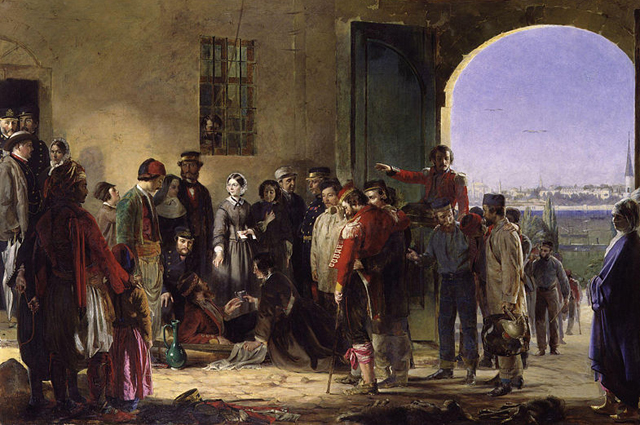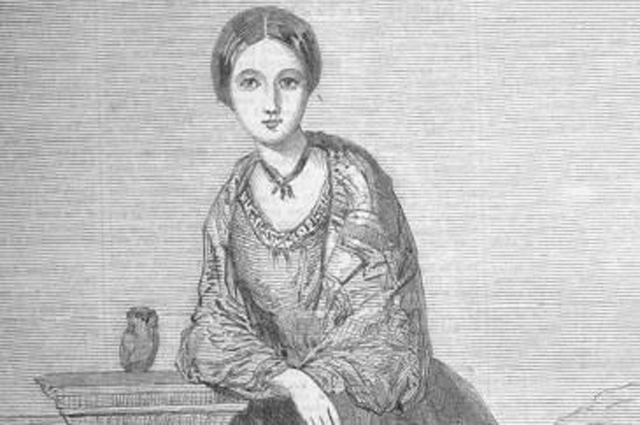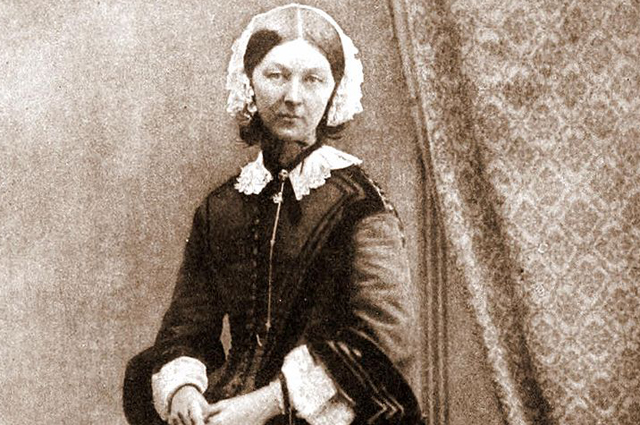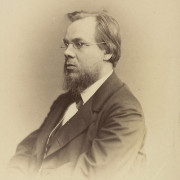Флоренс найтингейл биография, теория и вклады
Содержание:
- Леди с лампой
- Death
- Королевская миссия по спасению людей
- She loved science and mathematics from an early age
- Florence Nightingale: biography
- She was sent to Crimea to aid those in the war
- Theological Ideas and Activities
- She pushed an inquiry that exposed shocking statistics about disease
- Крымская война
- Признание
- Statistics, Sanitation, and Life Expectancy
- Background and Early Life
- Семейная сцена
- Recognition and Appreciation
- Florence Nightingale saves lives through hygiene
- Крымская война
Леди с лампой
Когда в 1955 году в прессе появился портрет Флоренс, – леди с лампой, ухаживающей за пациентами, она быстро приобрела множество своих поклонников. Ее работа в Скутари по улучшению условий жизни солдат в госпиталях была высоко оценена как прессой, так и общественностью.
 Флоренц на первой странице газеты Illustrated Times, 1856 г
Флоренц на первой странице газеты Illustrated Times, 1856 г
Ее семье приходилось продираться через постоянный поток сообщений и стихов, отправленных для Флоренции. Изображения «леди с лампой» печатали на сумках, циновках и сувенирах. Но Флоренс опасалась своей знаменитости. Хотя она вернулась домой героиней, все-равно старалась держаться в тени, путешествуя под псевдонимом «мисс Смит».
Death
In her senior years, Nightingale’s health was weakened because of brucellosis. However, the woman ignored the symptoms, such as depression and partial immobility, and headed the school of nurses; she did not stop writing scientific and journalistic texts as well.
Embed from Getty ImagesFlorence Nightingale in her last years
In the early 1900s, Florence’s efficiency decreased: blind and demented, she would stay in the bed and sometimes asked how things were going.
The social activist was 90 years old. She died on August 13, 1910, in her own house. Relatives did not have the cause of death revealed and buried her in St Margaret’s Church cemetery, Hampshire.
Королевская миссия по спасению людей
Только в 1856 году, после того, как в она переработала все, что узнала в Скутари, Флоренс использовала свою славу как мощное оружие для своей миссии по спасению жизней.
Преследуемая ужасающей гибелью людей, Флоренс встретилась с одной из своих самых больших поклонниц, королевой Викторией. При ее поддержке она убедила правительство создать Королевскую комиссию по охране здоровья армии.
Ведущий статистик Уильям Фарр и Джон Сазерленд из санитарной комиссии помогли ей проанализировать огромное количество сложных армейских данных. Правда, которую она открыла, была шокирующей – 16 000 из 18 000 смертей были вызваны не боевыми ранениями, а болезнями, распространяемыми из-за плохой санитарии, которые можно было предотвратить.
She loved science and mathematics from an early age
The sisters were home educated by their father, who taught them classics, philosophy and modern languages.
From a young age, Florence demonstrated a love of maths and sciences. She loved meticulous organisation of information, and documented her shell collection with tables and charts. Her sister, Parthenope, recognised her sister’s habits:
Young Florence Nightingale (Image Credit: Project Gutenberg / Public Domain)
In 1837, the Nightingale family toured Europe, hoping to equip the girls with a toolkit of arts and cultural knowledge, and increase their chances of finding an eligible husband. Much to her parents’ annoyance, Florence took time to record detailed notes of population statistics, charitable institutions and hospitals.
Florence Nightingale: biography
The British noblewoman Florence Nightingale is known as a social reformer, statistician, and founder of modern nursing. Her choice of a job was not typical for the higher circles. Nightingale became a prominent figure during the Crimean War and organized nursing care for wounded soldiers.
 The sister of mercy Florence Nightingale
The sister of mercy Florence Nightingale
Florence founded the first school of nursing in London and helped improve medical care for all layers of British society. The woman is famous for her simple, accessible instructions on how to administer first aid; she collected social statistics and information about patients, which was broadly used to analyze the situation in the country.
She was sent to Crimea to aid those in the war
In 1854, Britain entered the Crimean War. Newspapers were awash with horrific reports of the appalling conditions in army hospitals. The Secretary of State at War, Sidney Herbert, was a close friend of Nightingale. They had met several years previously, when Herbert was on his honeymoon in Rome.
Herbert appointed Nightingale to take 38 nurses to the military hospital in Scutari. It was the first time a woman had officially served in the army.
When she arrived in Scutari, it was clear that the newspaper horror stories were true.
A ward of the hospital at Scutari where Nightingale worked, from an 1856 lithograph by William Simpson. (Image Credit: William Simpson / CC)
The hospital, based in the old Turkish Selimiye Barracks, was coated in 1 inch of faeces, medicines were in short supply, and their was no equipment to process food for the patients.
Far more men died of cholera, dysentery, typhoid and malaria than battle wounds. Nightingale and her nurses set out to clean the hospital, but the death rates refused to drop.
She sent a plea to The Times for a government solution, the British Government sent out a Sanitary Commission, which revealed that the Barrack Hospital was built on a sewer which contaminated the water.
The government commissioned Isambard Kingdom Brunel to design a prefabricated solution. The Renkioi hospital was the pioneering result.
Theological Ideas and Activities
Nightingale’s religious vocation was central to her life, and her work lies within this vocation. Each year she reviewed her spiritual progress, and later she celebrated the jubilee of her first call. She read and translated medieval mystics in preparation for writing a book. Her invalidism has been attributed to chronic illness, post-traumatic stress, and a desire to escape from family demands, yet it also created a monastic existence in lieu of a religious or secular order. In 1860 Nightingale expanded Suggestions for Thought, sending drafts to six scholars, including Benjamin Jowett of Balliol College, Oxford, and the reformer John Stuart Mill. The manuscript addressed the same issues as Essays and Reviews (1860), a Church of England Broad Church Movement publication that resulted in heresy trials. While Essays and Reviews critiqued the church, Nightingale’s Suggestions for Thought offered the working class a reasonable religion that rejected the prevailing teaching that poverty was God’s will. Nightingale’s topics included God, universal law, God’s will, human will, sin, evil, family life, women, spirituality, and life after death. Mill quoted her in his parliamentary speech on women’s rights, and Jowett acknowledged the qualities of her mind, beginning a thirty-year intimate friendship with Nightingale.
Nightingale’s theology prefigured twentieth-century liberation theology, which begins not with traditional doctrines and ancient texts but with the experience of the oppressed, as does feminist theology. Nightingale suggested that oppressive social systems were human constructions held in place by the powerful, whether government or church, not God’s will. A liberating religion should not ask people to passively believe and accept their lot but make rational sense to everyone. Since God’s spirit was in all people, rich or poor, all could participate in God’s new society by learning, through observation, education, and statistical analysis, God’s will written in the universe. Nightingale called statistics a «sacred science» because it transcended individual experiences to uncover God’s larger thoughts, as her Crimean statistics demonstrated.
Prefiguring another contemporary debate, Nightingale argued that the concept of God evolved through history and was still evolving. While primal people propitiated an all-powerful God with sacrifice, worship, and prayer, believing suffering reflected divine displeasure, an arbitrary God intervening at will was not viable for a scientific age. A moratorium on God language was necessary until divine metaphors were reshaped. For Nightingale, God was embodied (incarnated) in the universe. Humans, as part of the universe, participated in this divinity, being drawn into mystic union with God through learning divine universal laws more reliable than claims of special revelation delivered in culturally bound language through selected interpreters. Good health and social conditions did not come by divine intervention but through human observation and application of divine laws.
Incarnation, Trinity, and theories localizing God in one incarnation and one day of suffering, while ignoring God’s suffering, work, and passion through eternity, needed rethinking. Medieval atonement ideas of God’s Son sacrificed because of divine offense at human sin were culturally bound explanations from an era demanding judgment and punishment, not reform. Instead, Nightingale’s Trinity comprised: (1) God as thought, purpose, and will-engendering development; (2) Son as divine manifestation in all humanity developing according to God’s will, Jesus being the perfect example and greatest teacher; and (3) Spirit as the divine in each, through which God as thought communicates. Life was about progressive learning from errors with the Spirit’s help, as well as help from many human saviors, like Nightingale, to lead to truth, both in this world and other reincarnations.
She pushed an inquiry that exposed shocking statistics about disease
Although she often travelled under the pseudonym, Miss Smith, Nightingale began to use her position of influence to further nursing interests.
With the support of Queen Victoria, she persuaded the government to set up a Royal Commission to explore the health of the army. They uncovered some shocking statistics – that 16,000 out of 18,000 deaths were due to diseases, not battle wounds.
‘Diagram of the Causes of Mortality in the Amy in the East’, dated 1858 by Florence Nightingale (Image Credit: Public Domain)
In 1857, Nightingale sought to demonstrate the effects of the Sanitary Commission through a diagram. This visual presentation is taken for granted now, but it was a relatively novel way of presenting data – the pie chart had first been developed by William Playfair in 1801.
The Rose diagram was widely republished, and brought the issue to the forefront of public attention. Nightingale described its effect on the British public,
The ever intrepid Dan Snow heads to the southwest of the Britain to uncover the region’s historical gems.
Watch Now
Крымская война
В 1853 году разразилась Крымская война. В газетах рассказывались ужасающие истории с линии фронта о страшных условиях в госпиталях британской армии.
Сидней Герберт, государственный секретарь по вопросам войны, хорошо знал Флоренс. Он поручил ей отвезти 38 медсестер в военный госпиталь в Скутари, Турция. Это был первый случай, когда женщинам разрешили официально служить в армии.
— Реклама —
По приезду Флоренс увидела в какой грязи находился госпиталь Барак. На полу были фекалии толщиной в дюйм. Она поручила медсестрам убирать в больнице и следила за тем, чтобы солдат правильно кормили и одевали. Впервые с регулярными войсками начали порядочно уважительно обращаться.
Однако, несмотря на все усилия Флоренции, число умерших среди раненых продолжало неумолимо увеличиваться, и за одну зиму погибло более четырех тысяч человек. Хотя она сделала больницу более эффективной, та не стала менее смертоносной.
Весной 1855 года для расследования условий в Скутари британское правительство направило санитарную комиссию. Выяснилось, что больница Barrack построена на канализации, а это значит, что пациенты пили зараженную воду. Госпиталь Барак, как и другие госпитали британской армии, были очищены и улучшили вентиляцию. Следовательно, смертность стала падать.
С 1855 по 1818 годы Флоренция также участвовала в проверках и реформировании прифронтовых госпиталей в Крыму.
Признание
В течение семи лет Флоренс стойко сносила постоянные ссоры с родителями и косые взгляды друзей и знакомых. После расторжения помолвки со Сноуфилдом обстановка в доме накалилась настолько, что пришлось покинуть родные стены. Мисс Найтингейл отправилась в один из английских монастырей, чтобы работать в тамошней больнице. Однако попытки устроить больничную жизнь на свой лад встретили неодобрение монашек, и Флоренс Найтингейл отправилась во Францию, чтобы ухаживать за больными в госпитале при католическом монастыре.
Статья по теме
«Я с начала апреля живу в клинике». Как работает медсестра в реанимации
Поступок для девушки, выросшей в порядочной семье английских протестантов, прямо скажем, неслыханный. Впрочем, Флоренс совсем не волновало всеобщее неодобрение. Гораздо важнее, что во Франции ей наконец позволили устроить больничную жизнь по своему разумению. Заразные больные тут же были отделены от прочих, палаты стали регулярно проветривать, сиделки делали все, что советовала им новенькая. В результате количество смертей в госпитале снизилось в два раза. Успехи мисс Найтингейл были настолько ошеломительны, что слухи о них достигли Лондона. Сама королева попросила Флоренс вернуться и предложила ей должность в больнице для обедневших дворянок. И снова оказалось, что методы Флоренс способны творить чудеса. Если раньше большинство больных из стен лечебного заведения отправлялись прямиком на кладбище, то теперь практически все они возвращались домой.

Statistics, Sanitation, and Life Expectancy
In 1859, Nightingale was elected to the Royal Statistical Society – its first female member.
She utilized her mathematical training to analyze the causes of sickness and death, first in hospitals and then in broader society. She popularized the use of polar area diagrams to ensure the points she was making could be understood by politicians and civil servants – from experience, she did not trust these people to read reports properly.
She often won arguments about the best way to proceed in healthcare through her mastery of statistics.
From her experiences in Scutari, she advocated sanitary reform for the British Army in India, which reduced the death rate from 69 to 18 per 1,000 within a decade.
In the UK as a whole, sanitary reforms advocated by Nightingale – compulsory sanitation in private homes for example – and supported by her statistics and polar charts are largely credited with improving average life expectancy by 20 years between 1871 and 1935.
One of Nightingale’s polar charts (digitally enhanced). Even a politician can read this to see that, as time passes, the number of deaths per month is getting smaller. The colors show the cause of death.
Some Personal Details and the End
Nightingale had a number of male admirers, and during her life received at least two proposals of marriage. However, she believed God had chosen her for her work, and she never married or had children.
She retained a lifelong affinity with the city she was named after, and loved to speak Italian and would use Italian words and phrases while speaking English with friends.
She loved music: her favorite composer was Mozart.
Florence Nightingale in her later years.
In 1883, she received the Royal Red Cross from Queen Victoria, who deeply admired Nightingale’s work, and invited her to speak with her on several occasions. In 1907, she became the first woman to be awarded the Order of Merit.
From about the age of 70, Nightingale slowed down and became less driven, spending more time enjoying the company of friends. In the last 10 years or so of her life, she lost most of her eyesight and became somewhat senile.
Florence Nightingale died in her sleep in London on August 13, 1910. She was 90 years old. She had been offered burial alongside some of Britain’s greatest heroes in Westminster Abbey, but turned this down. She actually requested her body be used for medical research, but this did not happen.
She was buried quietly, beside her parents, in the graveyard of St Margaret’s Church near her childhood home of Embley Park. There was a huge service in her honor at St. Paul’s Cathedral, attended by the King. A choir of 1,000 nurses sang at it.
Florence Nightingale was revered in her lifetime and is still revered today.
Advertisements
Images drawn or digitally enhanced and colorized by this website. All rights reserved.
Cite this Page
Please use the following MLA compliant citation:
"Florence Nightingale." Famous Scientists. famousscientists.org. 15 Aug. 2016. Web. <www.famousscientists.org/florence-nightingale/>.
Published by FamousScientists.org
Further Reading
Florence Nightingale
Notes on Nursing: What it Is, and What it is Not
D. Appleton, 1860
Florence Nightingale
Notes on Hospitals
Longman, 1863
Florence Nightingale
Measuring Hospital Care Outcomes
Joint Commission Resources, 1999
George Pickering
Creative Malady
George Allen & Unwin Ltd, London, 1974
Mark Bostridge
Florence Nightingale, the Woman and her Legend
Viking, 2008
Lynn McDonald
Florence Nightingale: An Introduction to Her Life and Family
Wilfrid Laurier Univ. Press, 2010
Background and Early Life
Nightingale was born on May 12, 1820, in Florence, Italy, the city which inspired her name. The younger of two daughters, Nightingale was part of an affluent British clan that belonged to elite social circles. Her mother, Frances Nightingale, hailed from a family of merchants and took pride in socializing with people of prominent standing. Despite her mother’s interests, Nightingale herself was reportedly awkward in social situations and preferred to avoid being the center of attention whenever possible. Strong-willed, she often butted heads with her mother, whom she viewed as overly controlling.
Nightingale’s father was William Edward Nightingale (having changed his original surname, «Shore»), a wealthy landowner who would be associated with two estates—one at Lea Hurst, Derbyshire, and the other at Embly, Hampshire. Nightingale was provided with a classical education, including studies in mathematics along with German, French and Italian.
From a young age, Nightingale was active in philanthropy, ministering to the ill and poor people in the village neighboring her family’s estate. Nightingale eventually came to the conclusion that nursing was her calling; she believed the vocation to be her divine purpose.
When Nightingale approached her parents and told them about her ambitions to become a nurse, they were not pleased and forbade her to pursue appropriate training. During the Victorian Era, where English women had almost no property rights, a young lady of Nightingale’s social stature was expected to marry a man of means to ensure her class standing—not take up a job that was viewed by the upper social classes as lowly menial labor.
In 1849, Nightingale refused a marriage proposal from a «suitable» gentleman, Richard Monckton Milnes, who had pursued her for years. She explained her reason for turning him down, saying that while he stimulated her intellectually and romantically, her «moral…active nature» called for something beyond a domestic life. (One biographer has suggested that the rejection of marriage to Milnes was not in fact an outright refusal.) Determined to pursue her true calling despite her parents’ objections, Nightingale eventually enrolled as a nursing student in 1850 at the Institution of Protestant Deaconesses in Kaiserswerth, Germany.
Семейная сцена
«Поплакать бы, только вместо слез и жалости к себе одна сплошная злость и досада. Ну почему, почему родители, такие умные, современные люди, считают, что она – позор семьи, хотя единственная ее провинность состоит в том, что она хочет заниматься своим любимым делом и решительно расправляется со всем, что ей мешает, даже с собственной помолвкой. Конечно, маму с папой можно понять. Артур-Арчибальд Сноуфилд – прекрасная партия. Он образован, у него в руках уважаемая профессия врача, он любезен, обеспечен и даже красив. Отличный вариант для любой девушки, а уж для тридцатилетней старой девы Флоренс и вовсе подарок судьбы. Неудивительно, что после того, как она объявила о разрыве помолвки, родители не только устроили грандиозный скандал, да еще и в запале лишили дочь наследства. Да бог с ним, с наследством. Не нужны мне никакие деньги. Лишь бы меня оставили в покое и дали заниматься тем, что мне по-настоящему нравится – ухаживать за больными и ранеными. В конце концов, я не виновата, что Артур оказался таким же ханжой, как все. А ведь как хорошо все начиналось. Он – врач, с ним можно было поговорить о том, как лучше наладить дела в больнице, обсудить, что требуется моим подопечным. Мы могли целыми днями быть вместе и не уставать друг от друга. Ну почему, как только была объявлена помолвка, он вдруг заявил, что я должна бросить госпиталь? Неужели он не понимает, что эта работа для меня дороже всего на свете?», – думала Флоренс Найтингейл, дочь английских аристократов, леди до кончиков ногтей и бывшая обладательница солидного наследства.

Нужно признать, что в тогдашние интерьеры больниц Флоренс действительно вписывалась плохо. Уж очень сильно отличался ее облик от привычного вида сиделок. В те времена о больных заботились самые бедные, самые никчемные барышни, которые просто не сумели устроиться в другое место. Часто – из-за чрезмерной тяги к выпивке.
Грязные, оборванные, в лучшем случае они просто сидели рядом с больными, ничем не пытаясь помочь, а в худшем – падали рядом с умирающими и забывались тяжелым похмельным сном. И вдруг – Флоренс. «Леди со светильником», «ангел милосердия», как только не называли ее раненые во время Крымской кампании. Флоренс всеми силами старалась облегчить их страдания и первая превратила уход за больными в науку, со своими формулами и строгими правилами. Неудивительно, что среди ее подопечных смертность была в десятки раз ниже, чем там, где за ранеными присматривали обычные сиделки. А книги, написанные мисс Найтингейл, многие десятилетия оставались пособием для медицинских сестер.

Recognition and Appreciation
Nightingale decided to use the money to further her cause. In 1860, she funded the establishment of St. Thomas’ Hospital, and within it, the Nightingale Training School for Nurses. Nightingale became a figure of public admiration. Poems, songs and plays were written and dedicated in the heroine’s honor. Young women aspired to be like her. Eager to follow her example, even women from the wealthy upper classes started enrolling at the training school. Thanks to Nightingale, nursing was no longer frowned upon by the upper classes; it had, in fact, come to be viewed as an honorable vocation.
Based on her observations during the Crimea War, Nightingale wrote Notes on Matters Affecting the Health, Efficiency and Hospital Administration of the British Army, a massive report published in 1858 analyzing her experience and proposing reforms for other military hospitals. Her research would spark a total restructuring of the War Office’s administrative department, including the establishment of a Royal Commission for the Health of the Army in 1857. Nightingale was also noted for her statistician skills, creating coxcomb pie charts on patient mortality in Scutari that would influence the direction of medical epidemiology.
Florence Nightingale saves lives through hygiene
Florence Nightingale’s talent as a nurse became apparent quickly as she moved up through the rankings at the hospital where she was employed. She was instrumental in controlling a at her hospital due to her insistence on the implementation of sanitary practices.
Florence was a staunch advocate for practices, which in turn saved the lives of many of her patients throughout her career. This is especially true for her role in the Crimean War, in which the British fought the Russians for control of the Ottoman Empire.
Advertisement

Florence was sent to Crimea to care for soldiers and was appalled at the squalid conditions of the hospitals.
She later went to Constantinople (now Istanbul, Turkey) to the main hospital for British soldiers. The Barrack Hospital in Scutari, which is now a district of Istanbul called Uskudar, was nightmarish. The floors were covered in layers of human waste, the hospital was overrun by rodents and insects.
Perhaps worst of all, it turns out that the hospital had been built over a sewer and the water was toxic.
Florence mobilized the hospital, patients, and staff alike, in a massive cleaning effort. The soldiers until then had been dying not of their wounds but of communicable diseases like and . After the hospital was cleaned and hygiene standards were implemented, the death rate was reduced by an astounding two thirds.
Advertisement
Крымская война
В начале 1850-х годов Соловей вернулась в Лондон, где устроилась на работу медсестрой в больницу на Харли-стрит для больных гувернанток. Ее работа там так впечатлила ее работодателя, что Найтингейл был назначен начальником. Соловей также добровольно вызвался в больницу Мидлсекса примерно в это время, борясь со вспышкой холеры и антисанитарными условиями, способствующими быстрому распространению болезни. Соловей сделал своей миссией улучшение гигиенических практик, значительно снижая уровень смертности в больнице.
В октябре 1853 года началась Крымская война. Союзные британские и французские войска воевали против Российской империи за контроль над османской территорией. Тысячи британских солдат были отправлены в Черное море, где поставки быстро сократились. К 1854 году в военные госпитали поступило не менее 18 000 солдат.
В то время в больницах Крыма не было медсестер. После битвы при Альме Англия была в шуме из-за пренебрежения их больными и ранеными солдатами, которым не только не хватало медицинской помощи из-за ужасно недоукомплектованных больниц, но и томление в ужасающе антисанитарных условиях.









